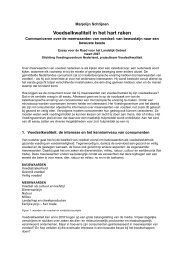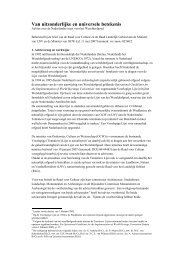Landbouw en landgebruik in internationaal perspectief Voorwoord
Landbouw en landgebruik in internationaal perspectief Voorwoord
Landbouw en landgebruik in internationaal perspectief Voorwoord
Create successful ePaper yourself
Turn your PDF publications into a flip-book with our unique Google optimized e-Paper software.
the first objective of land use, with agricultural production <strong>in</strong> the conv<strong>en</strong>tional s<strong>en</strong>se as the<br />
secondary objective. This could have profound implications for many parts of Europe where<br />
agriculture is <strong>in</strong>her<strong>en</strong>tly unprofitable and only ma<strong>in</strong>ta<strong>in</strong>ed by public support.<br />
Several contributions to the sem<strong>in</strong>ar have described other pot<strong>en</strong>tial attributes of this model -<br />
Sara Scherr's maxim of 'gett<strong>in</strong>g biomass <strong>in</strong>, rather than tak<strong>in</strong>g biomass out', and the notion of<br />
substitut<strong>in</strong>g natural capital (the capacity for produc<strong>in</strong>g ecosystem services) for f<strong>in</strong>ancial<br />
capital. There is much to be done to develop and ref<strong>in</strong>e the model, and perhaps ev<strong>en</strong> more to<br />
communicate it - because it will count for very little unless it can be shared by land users,<br />
policy makers, and preferably by the wider European public.<br />
Markets have a vital function <strong>in</strong> meet<strong>in</strong>g our objectives for mitigat<strong>in</strong>g climate change and<br />
achiev<strong>in</strong>g food security and <strong>en</strong>ergy security. We need to recognise this and use market forces<br />
constructively. The sem<strong>in</strong>ar has drawn att<strong>en</strong>tion to how market mechanisms can be developed<br />
as a way of <strong>in</strong>c<strong>en</strong>tivis<strong>in</strong>g the managem<strong>en</strong>t of ecosystem services. In particular there appears to<br />
be strong g<strong>en</strong>eral support for a much expanded system of <strong>en</strong>vironm<strong>en</strong>tal taxation.<br />
If some of these ecosystem services, particularly those responsible for the stability of the<br />
climate, are issues of human survival, perhaps they should cause us to reconsider our<br />
approach to regulation and how we <strong>in</strong>terv<strong>en</strong>e <strong>in</strong> markets. If someth<strong>in</strong>g is so very important,<br />
can we afford to leave it to a voluntary approach where land managers make free choices <strong>in</strong><br />
response to largely unregulated markets?<br />
A system of regulation that might be able to achieve the necessary balance betwe<strong>en</strong> the<br />
demands of food security, <strong>en</strong>ergy supply and the purer <strong>en</strong>vironm<strong>en</strong>tal public goods (which<br />
may or may not <strong>in</strong>clude action to counteract climate change) is likely to <strong>in</strong>volve land use<br />
plann<strong>in</strong>g. This is easy to say, but at this stage most of us have only a vague notion of what a<br />
land use plan or, perhaps more importantly, a strategy for implem<strong>en</strong>t<strong>in</strong>g it would look like.<br />
This sem<strong>in</strong>ar has raised many chall<strong>en</strong>ges that a land use plan would need to address:<br />
the <strong>in</strong>tegration of multiple functions and objectives. 'If you take ecosystem services one at a<br />
time, you get th<strong>in</strong>gs completely wrong', as the <strong>en</strong>vironm<strong>en</strong>t discussion group po<strong>in</strong>ted out;<br />
tak<strong>in</strong>g global and trans-national factors <strong>in</strong>to account;<br />
sett<strong>in</strong>g targets, based on a shift from trade-offs to synergies or, at least, 'shift<strong>in</strong>g the tradeoff<br />
curve' (Sara Scherr);<br />
match<strong>in</strong>g the balance of outcomes to the natural capacity for produc<strong>in</strong>g them - 'work<strong>in</strong>g with<br />
nature';<br />
build<strong>in</strong>g on the pot<strong>en</strong>tial of new technology as the means of mak<strong>in</strong>g more effici<strong>en</strong>t use of<br />
<strong>en</strong>vironm<strong>en</strong>tal resources;<br />
<strong>in</strong>volv<strong>in</strong>g stakeholders, and develop<strong>in</strong>g ownership of the process.<br />
An ess<strong>en</strong>tial prerequisite for such a plan will be the ability to attach a value to the outcomes<br />
for which we are plann<strong>in</strong>g - requir<strong>in</strong>g not only the application of new techniques, but also the<br />
substantial adjustm<strong>en</strong>t of perceptions.<br />
Return<strong>in</strong>g to the global recession, ev<strong>en</strong> while its full impact is not yet appar<strong>en</strong>t there are some<br />
lessons we can learn from it about Europe's land use and <strong>en</strong>vironm<strong>en</strong>t. First, it re<strong>in</strong>forces our<br />
awar<strong>en</strong>ess of land use as a global <strong>en</strong>vironm<strong>en</strong>tal issue; it shows us that there can be ev<strong>en</strong>ts on<br />
a global scale with the pot<strong>en</strong>tial for a major <strong>in</strong>flu<strong>en</strong>ce on the <strong>en</strong>vironm<strong>en</strong>t that are beyond the<br />
reach of our modell<strong>in</strong>g and sc<strong>en</strong>ario-build<strong>in</strong>g. Second, it po<strong>in</strong>ts to cont<strong>in</strong>u<strong>in</strong>g unpredictability



!['Zwaveldioxide en zwaveltrioxide' [pdf] - Raad voor de leefomgeving ...](https://img.yumpu.com/20578080/1/184x260/zwaveldioxide-en-zwaveltrioxide-pdf-raad-voor-de-leefomgeving-.jpg?quality=85)


!['Ammoniak als koudemiddel' [pdf] - Raad voor de leefomgeving en ...](https://img.yumpu.com/20336041/1/184x260/ammoniak-als-koudemiddel-pdf-raad-voor-de-leefomgeving-en-.jpg?quality=85)

!['Reacties uit het veld' [pdf]](https://img.yumpu.com/20207000/1/184x260/reacties-uit-het-veld-pdf.jpg?quality=85)


![Download het volledige advies 'Ruimte voor duurzame landbouw' [pdf]](https://img.yumpu.com/19986529/1/188x260/download-het-volledige-advies-ruimte-voor-duurzame-landbouw-pdf.jpg?quality=85)


